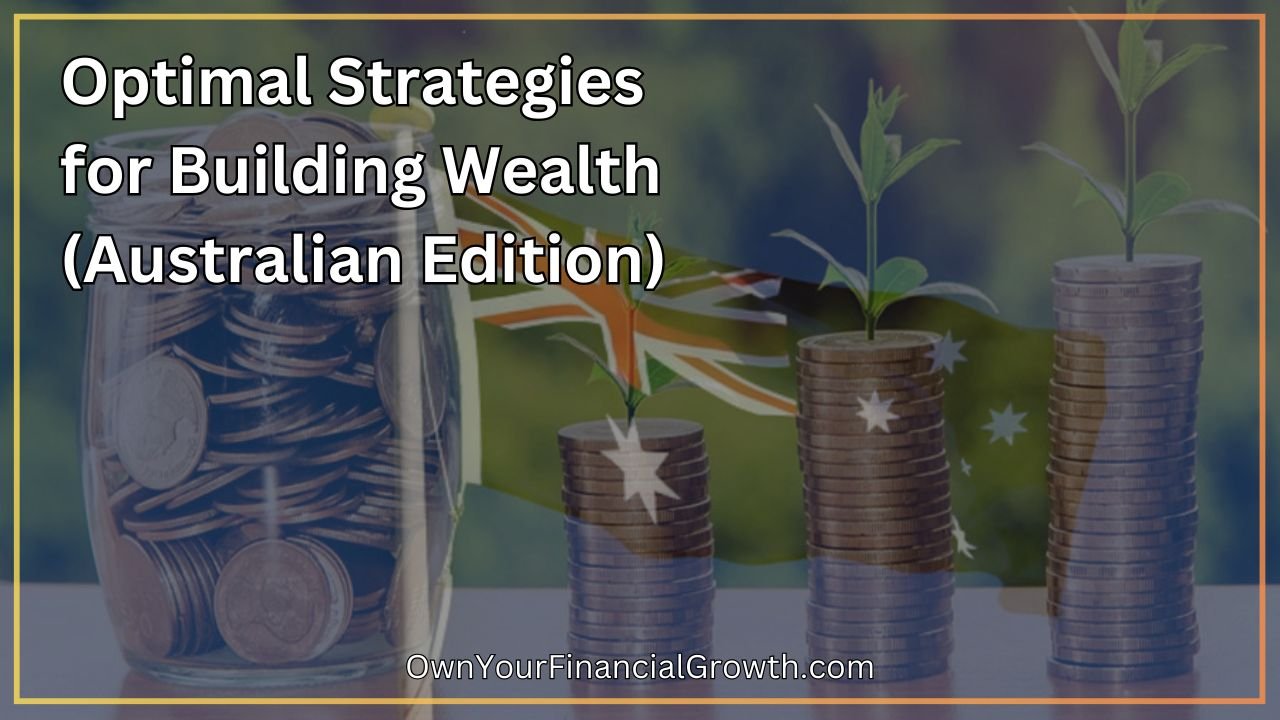Financial planning can be a bit like solving a puzzle. Each piece needs to fit together to complete the bigger picture of financial security. If you are an Aussie wanting to learn how to grow your money effectively, we cover the optimal strategies for building wealth in this article.
One of the most important aspects of this puzzle is knowing the right order to save and invest your money. Getting this order right can make a huge difference in how quickly you achieve your financial goals.
Whether you’re just starting out or looking to refine your strategy, understanding the optimal order of saving and investing is crucial for Australians who want to make the most of their money.

Key takeaways
- Start with an emergency fund: Before investing, ensure you have a safety net by saving at least three months of living expenses.
- Prioritize paying off high-interest debt: Focus on clearing high-interest debts like credit cards to avoid financial strain and free up funds for saving and investing.
- Maximize your superannuation: Take advantage of Australia’s superannuation system by contributing early and regularly to build a substantial retirement fund.
- Implement a regular savings plan: Set up automated savings for short-term goals, using high-interest savings accounts to grow your money efficiently.
- Diversify your investments: Build a diversified portfolio that includes various asset classes like stocks, bonds, and real estate to minimize risk and maximize returns.
- Consider tax-efficient investment strategies: Utilize tax-efficient options like franking credits and long-term capital gains discounts to enhance your investment returns.
- Explore real estate as a wealth-building tool: Investing in Australian property can offer both capital growth and rental income, making it a key component of a wealth-building strategy.
- Evaluate alternative investments: Consider diversifying further with alternative assets like cryptocurrencies and commodities, but be aware of the associated risks.
- Regularly review and adjust your financial plan: Keep your financial plan aligned with your goals by reviewing and adjusting it regularly, especially after major life or financial changes.
- Protect your assets with insurance: Adequate insurance coverage, including life, health, and income protection, is essential to safeguard your wealth.
- Plan for retirement early: Start planning for retirement as soon as possible, aiming to build a diversified portfolio that provides a stable income during your retirement years.
- Include estate planning in your strategy: Ensure your assets are distributed according to your wishes and that your loved ones are taken care of by incorporating estate planning into your financial strategy.
Understanding your financial situation
Before diving into saving and investing, it’s essential to get a clear picture of your current financial situation. This means taking stock of your income, expenses, debts, and existing savings.
Setting clear financial goals is the next step – whether it’s buying a house, retiring early, or simply achieving financial independence.
The foundation of all this is a solid budget. A budget isn’t just a plan for your money; it’s a tool that helps you allocate your resources effectively, ensuring that every dollar has a purpose.
Start by listing your income and expenses. Use apps or a simple spreadsheet to track every dollar. This way, you’ll know exactly how much you’re spending on coffee, eating out, or shopping. Knowing your spending habits is the first step to making better financial decisions.
Step 1: Build an emergency fund
The first step in any financial plan should be to build an emergency fund. Think of this as your financial safety net.
Life is unpredictable, and having a cushion to fall back on during tough times is invaluable. An emergency fund should cover three to six months of living expenses, giving you peace of mind and the ability to handle unexpected costs without derailing your financial goals.
Step 2: Pay off high-interest debt
Once your emergency fund is in place, the next priority should be tackling any high-interest debt. This includes credit card balances, personal loans, and any other debts with an interest rate that’s dragging down your financial progress.
High-interest debt can quickly snowball, making it harder to get ahead financially.
Focus on paying off these debts as quickly as possible to free up more money for savings and investments.
Step 3: Take advantage of superannuation
In Australia, superannuation (“super”) is one of the most effective ways to save for retirement. The earlier you start contributing to your super, the more time your money has to grow.
Even if retirement seems far off, making additional contributions to your super fund can provide significant tax benefits and help you build a substantial nest egg over time.
Consider salary sacrificing through your employer, or making personal contributions into your super fund to take full advantage of this system and to grow your nest egg even faster.
Step 4: Start a regular savings plan
With your emergency fund in place, debts under control, and superannuation contributions sorted, it’s time to think about a regular savings plan. This is where you save for short-term goals like a holiday, a new car, or even a house deposit.
Choose a high-interest savings account or an offset account linked to your mortgage to make your savings work harder for you.
Automating your savings is a great way to ensure you stay consistent and reach your goals faster. This can be managed by setting up scheduled transfers to different bank accounts each time you get paid.
Step 5: Invest in a diversified portfolio
Once your short-term savings are on track, it’s time to start investing.
Investing is essential for building wealth over the long term, but it’s important to approach it with a well-diversified portfolio. This means spreading your investments across different asset classes, such as stocks, bonds, and property, to minimize risk.
In Australia, you have access to a wide range of investment options, including exchange-traded funds (ETFs), managed funds, and direct shares.
A diversified portfolio can help you grow your wealth steadily while protecting you from market volatility.
Step 6: Consider tax-efficient investments
Taxes can eat into your investment returns if you’re not careful. That’s why it’s essential to consider tax-efficient investment strategies.
In Australia, some investments come with tax advantages, such as shares that pay dividends with franking credits. These credits can reduce the amount of tax you pay on your investment income.
Additionally, holding investments for longer than 12 months can qualify you for a capital gains tax discount.
Understanding these strategies and incorporating them into your plan can boost your overall returns.
Step 7: Build wealth through real estate
Real estate has long been a popular investment choice in Australia, thanks to the country’s booming property market. Investing in property can provide both capital growth and rental income, making it an attractive option for wealth building.
Whether you’re considering buying your first investment property or expanding your portfolio, it’s important to research the market thoroughly and understand the costs involved, such as stamp duty, legal fees, and ongoing maintenance.
Real estate can be a significant wealth-building tool when approached with the right strategy.
Step 8: Explore additional investment opportunities
Beyond traditional assets like stocks and property, there are alternative investment opportunities that can diversify your portfolio further. These include investments in commodities, cryptocurrencies, and even peer-to-peer lending.
While these options can offer higher returns, they also come with higher risks. It’s crucial to do your homework and understand these investments before committing your money.
Adding a small portion of alternative assets to your portfolio can enhance diversification and potentially increase returns.
Step 9: Regularly review and adjust your strategy
Financial planning isn’t a one-and-done task. As life changes – whether it’s getting married, having children, changing jobs, or approaching retirement – your financial strategy needs to adapt.
Regularly reviewing and adjusting your savings and investment plan ensures that it stays aligned with your goals. This might involve increasing your super contributions, adjusting your investment portfolio, or rebalancing your assets.
Don’t hesitate to seek professional financial advice to help optimize your strategy as your circumstances evolve.
Step 10: Protect your wealth with insurance
Insurance plays a critical role in protecting the wealth you’ve worked hard to build. At a minimum, every Australian should consider life insurance, income protection, and health insurance.
Depending on your circumstances, you might also need home and contents insurance, as well as coverage for critical illness or disability.
While it’s essential to have adequate insurance, it’s equally important to ensure that you’re not over-insured. Balancing your insurance needs with the cost of premiums is key to maintaining a healthy financial plan.
Step 11: Plan for retirement
Retirement might feel like a distant goal, but it’s never too early to start planning. The sooner you begin planning for retirement, the more time your investments have to grow.
Consider how much you’ll need to retire comfortably and set a target retirement age. This will help you determine how much to save and invest each year. Use our retirement calculator to help find that target!
Superannuation will likely be a significant part of your retirement income, but it’s also wise to have additional investments, such as shares, property, or a managed fund, to supplement your Super.
The goal is to build a diversified retirement portfolio that provides a stable income in your golden years.
Step 12: Estate planning
Estate planning is often overlooked, but it’s a crucial part of a comprehensive financial strategy. It involves more than just writing a will; it’s about ensuring that your assets are distributed according to your wishes and that your loved ones are taken care of.
This might include setting up a trust, choosing an executor, and making arrangements for any dependents. Proper estate planning can also minimize the tax burden on your heirs and ensure a smooth transition of your assets.
Final thoughts
The optimal order of saving and investing is a strategic process that can set you on the path to financial success.
By following these steps – building an emergency fund, paying off high-interest debt, contributing to your super, saving regularly, investing wisely, and planning for the future – you can achieve your financial goals and secure your financial future.
It’s a journey that requires discipline, patience, and regular review, but the rewards are well worth the effort.
Start today, and take control of your financial destiny!
FAQs
1. How much should I save before I start investing?
It’s generally recommended to save three to six months of living expenses in an emergency fund before you start investing. This ensures you have a safety net in case of unexpected expenses.
2. What’s the best way to pay off debt quickly?
The most effective way (mathematically) to pay off debt sooner is to focus on high-interest debt first while making minimum payments on other debts. This is termed the debt snowball method. Another strategy is the debt avalanche method, whereby you focus on paying off debts from the smallest to the largest.
3. How can I maximize my superannuation benefits?
You can maximize your super by making additional contributions and choosing a super fund with low fees and strong performance.
4. What are the most tax-efficient investments in Australia?
Tax-efficient investments in Australia include shares with franking credits, holding investments for longer than 12 months to qualify for the capital gains tax discount, and contributing to your Superannuation.
5. How often should I review my financial plan?
It’s advisable to review your financial plan at least once a year or whenever there’s a significant change in your life, such as a new job, marriage, or the birth of a child.
Image attribution: Pixabay, Pixabay





